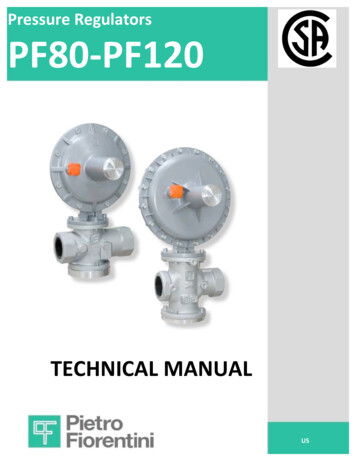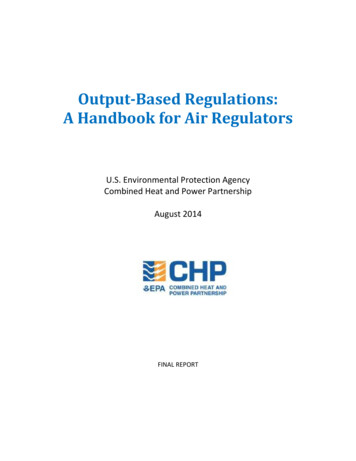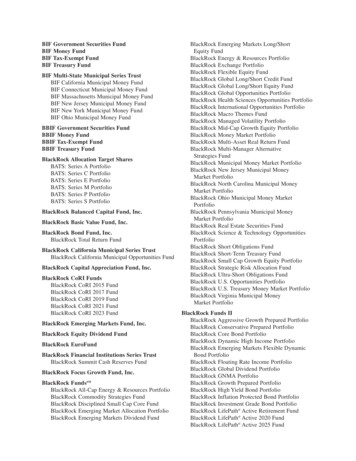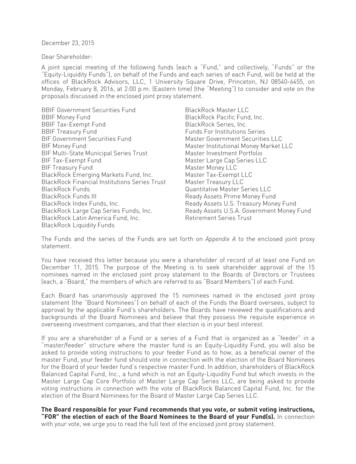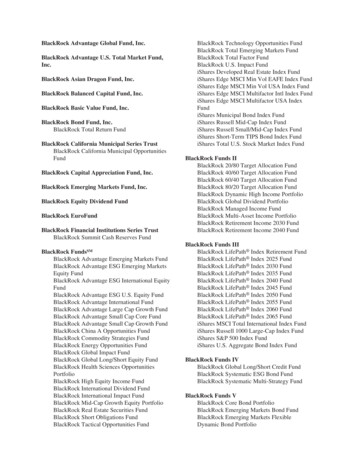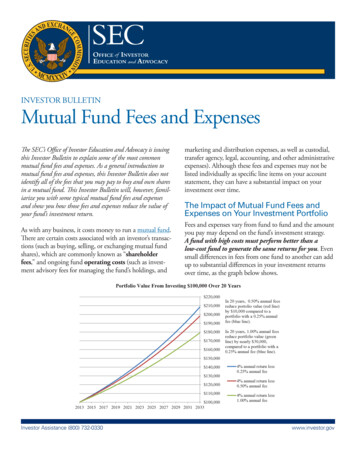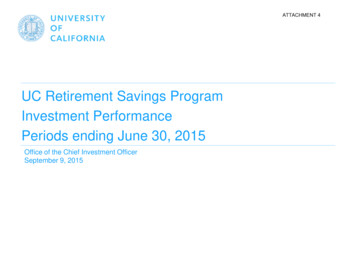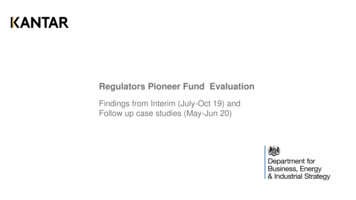
Transcription
Regulators Pioneer Fund EvaluationFindings from Interim (July-Oct 19) andFollow up case studies (May-Jun 20)
The high level objectives of the Regulators Pioneer FundThe Regulators Pioneer Fund (RPF) is an initiative set up by the Better Regulation Executive (BRE), part of the Departmentfor Business, Energy and Industrial Strategy (BEIS), to help create a regulatory environment that gives innovativebusinesses the confidence to invest, innovate and deploy emerging technologies for the benefit of consumers and the widereconomy.Key aims of the funding, which will invest up to 10 million over 2 years in 15 regulator-led projects across 12 sectors are:Enabling economic growthBoosting value for consumersProjecting a pro-innovationimage internationallyFostering a pro-innovationbusiness cultureAims of the RPF programme evaluation Assess the extent to which RPF grants have enabled regulators to become more innovation-enabling Identify the effects on business innovation in the sectors impacted by the projects Enable BEIS to improve the RPF design and competition process for any future funding rounds Contribute to BEIS work to create best practice guidance on innovation friendly regulation and inform future policydecisions2
The policy logic model for the RPF is set below:OUTPUTSOUTCOMESIMPACTS(outside of scope of theevaluation)RPF regulator(s) permits new business innovation (e.g.products, services, processes, business models), forexample through new licensing or sandbox regimeRPF regulator(s) stimulates new business innovation(e.g. products, services, processes, business models),for example by setting challenging outcomes orreleasing new informationRPF regulator(s) reduces time or cost of introducingbusiness innovation (e.g. products, services, processes,business models), for example by providing betteradvice or simplifying processesIncreased generation of ideas (e.g.products, services, processes,business models) by businessesoperating in the UKFaster, more sustained growth inproductivity and wagesIncreased investment in innovation inthe UKIncreased resilience to economicshocksRPF regulator(s) improves business or investorconfidence in how business innovation (e.g. products,services, processes, business models) will beregulated, for example through comms.Increased competition (i.e. increasedentry and exit to UK markets)RPF regulator(s) improves consumer confidence inbusiness innovation (e.g. products, services, processes,business models), for example through improvingprotections or enhancing comms.Increased consumption of innovation(e.g. through greater consumerconfidence) – i.e. increased UKmarket sizeRPF regulator(s) influences other UK regulators totake a pro-innovation regulatory approach, for examplethrough forming partnerships or disseminating findingsGOALSLower regulatory barriers to trade (e.g.through global regulatory influence),with increased overseas market sizeIncreased quality/quantity of businessinnovation (e.g. products, services,processes, business models) thatbenefits the economy, society and theenvironmentFaster delivery of wider benefitsof economic development (e.g.wider consumer choice, advancesin medicine, transport, etc.)Better outcomes for consumers,workers, citizens and theenvironmentRPF regulator(s) influences other administrations toalign with its regulatory approach3
Three case studies were selected to show early lessons from the programmeQualitative interviews were conducted with regulators and their external stakeholders to explore their perspectiveson progress, impact and lessons learnt. These were: The project team involved in the bidand delivery Three external stakeholders involvedin the project in different capacities The project team involved in the bidand delivery Two external stakeholders involved inthe project in different capacities The project team involved in the bidand delivery Three external stakeholders involvedin the project in different capacitiesFor each case study, early lessons have been captured from the following phases and themes:Project nnovation throughregulationRPF Evaluation – Interim case studiesValue of theRPF4
Case study methodology – Interim Case StudiesParticipants’ selection and data collection Regulators interviewed for the case studies were selected by BEIS and Kantar to reflect emerging lessons from their projects.For each project, the research team conducted: 1x 60 mins semi structured qualitative interview with key members of the project team (e.g. project and programme manager or bidmanager, depending on team composition); 1x 60 mins semi structured qualitative interview with a strategic lead overseeing the project; 3x 30 mins interviews stakeholders (e.g.delivery partners, businesses or other organisations operating in the sectors, other regulators) identified by the regulators and selected by BEIS. 2x 30 mins stakeholder interviews wereconducted for the MHRA case studies because of limited stakeholder availability.Fieldwork was conducted between July and August 2019 (9 months into regulators’ projects). These interim case studies follow two rounds of a quarterly information managementquestionnaire delivered by Kantar. This questionnaire was used to understand how far projects were achieving the outputs and outcomes in the RPF logic model (see slide 3). Topicsexplored are included below: Project team / strategic lead**The same topic guide was used flexibly to explore different perspectivesStakeholders Regulators’ understanding of the RPF and motivations to apply for funding; Vision for the project and connection with organisational mission; Experiences of main stages of work (e.g. set up, internal and external engagement,delivery of project specific activities); Expected and unexpected challenges encountered; Lessons they learnt about enabling innovation in their sector, engaging with businesses,regulators and other stakeholders; Any emerging outcomes of their project on innovation in their sector; Perceptions of RPF support, any impact the Fund had on their ability to enableinnovation in their sector, and ways the RPF could be improved for the future. Stakeholders’ exposure to and perspective on regulators’ work;Nature of their involvement and views on their engagement with regulators;Ways in which regulators can more effectively engage with stakeholders toenable innovation in their sectors;Any perceived initial outcomes and benefits deriving from regulators’ projects;Views on future outcomes and how regulatory activity could be improved toencourage innovation.Analysis of the information collected through the case studies interviews Material collected in interviews (e.g. audio files, notes) were organised through a thematic framework developed in Excel, informed by evaluation objectives.Individual and joint brainstorming sessions were carried out by researchers in the Kantar team to review and consolidate insight, and draw key overarching themes.RPF Evaluation – Interim case studies5
Case study methodology – Follow-up Case StudiesThe following slides include updated findings from follow up qualitative interviews carried out with SRA between May and June 2020 (once their project concluded). These slides outlinefurther progress, achievements and lessons learnt.For each project the project team conducted 1x60 mins semi structured qualitative interview with the project team. Interviews covered additional activities carried out since the previousinterview with Kantar: challenges faced; additional achievements and outcomes; lessons learnt about enabling innovations in their sectors through regulatory activity; perceptions of RPFsupport and plans to continue their innovation work past the RPF lifetime.Material collected in interviews (e.g. audio files, notes) were organised through a thematic framework developed in Excel and analysed in individual and joint brainstorming sessionscarried out by researchers in the Kantar team.RPF Evaluation – Interim case studies6
Cross cutting lessons (October 2019)RPF Evaluation – Interim case studies7
Interim lessons from the case studies (October 2019) The regulators interviewed noted that their experience of the Regulators’ Pioneer Fund programme had been very positive andvaluable. They felt that the RPF had provided them with:oTime and resources to work on issues that may otherwise fall outside the scope of their day to day activities and operatingmodels;oOpportunities to engage and collaborate with stakeholders (e.g. regulated businesses, other regulators (within andoutside their sector), academia, tech innovators) to learn and understand the issues relating to innovation;o Impetus to seed cultural change within their own organisation and an opportunity to create networks and partnerships tocontinue and deliver impact in the sector after RPF funding has terminated.oBeyond this, regulators also highlighted some areas in which they felt lessons (about the RPF design) could be drawn forfuture engagement:oRegulators explained that they didn’t feel fully prepared to start activities on their project when they were awarded fundingand would have welcomed a longer time window between notification of a successful bid and the start of funding to set uptheir project;oRegulators also thought they would have benefitted from additional clarity on the administrative responsibilities connectedwith being awarded RPF funding. In particular, SRA and MHRA struggled with some of Innovate UK’s audit requirements,which delayed them in receiving payment;oAdditionally, both MHRA and CAA explained that they found funders’ decision to split the project budget over the twofinancial years of the project seemingly without flexibility to reallocate challenging. This issue was exacerbated by theshort setup timescales as detailed above, as both CAA and MHRA faced delays at the beginning of their projects.RPF Evaluation – Interim case studies8
Interim lessons from the case studies (continued) (October 2019) Regulators were of the view that it was too early to evaluate the impact of their projects and provide conclusive lessons onhow the programme can best enable innovation in their sector. However, they felt that the programme had already allowedthem to achieve positive results. They explained that their engagement with innovators and other stakeholders within theirsector had allowed them to understand their sector better, to embrace different ways of working and to create fruitfulcollaborations both within and beyond their sector. Thinking about the future, regulators highlighted elements of their projects that they would want to continue beyond the end ofthe programme, for example:oMHRA’s funded work covers a feasibility study for the development of synthetic data, and they hope to conduct futurework to understand how to integrate this into their regulatory activities. CAA’s Innovation Hub has experienced highindustry demand for continued support via their sandbox and other international engagement activities beyond the RPFfunding end date of March 2020 but have not so far had confirmation that they would secure internal funding and areassessing access to external funding opportunities.oSRA explained that they found the Regulators Innovation Network, created for the RPF, extremely valuable as a way toshare their thinking with other regulators. They thought the network should continue to exist past the end of this edition ofthe RPF so that regulators can continue to collaborate and share their experiences to foster innovation across sectors.They reported they are starting to look into how to develop their networks from the project to make sure they have anongoing impact.RPF Evaluation – Interim case studies9
Case study 1 – Interim Findings (Oct 2019)Solicitors Regulators Authority (SRA)Data-driven Innovation in Legal ServicesRPF Evaluation – Interim case studies10
Project at a glance – Data-driven Innovation in Legal ServicesThe SRA is the regulator of solicitors and law firms in England andWales. They regulate more than 180,000 solicitors in England andWales.Role as theregulatorThe SRA’s purpose is to protect the public by ensuring thatsolicitors meet high standards, and by acting when risks areidentified.The SRA’s policy team explained it has been active in supportinginnovation in delivery of legal services.Key components of the project (in partnership with Nesta):MainactivitiesinvolvedThe SRA project consists of the Legal Access Challenge, acompetition designed to enable the development of innovativedigital technologies to make obtaining legal help affordable,understandable and convenient for users, particularly those underserved at present.Vision forRPF fundedprojectShort term, the SRA said their vision is to bring “real new solutions”to the sector to improve access to justice. Long term, their aim is toupskill themselves and modernise their regulation, engaging withstrategic questions about how they regulate in a changing sector.“Embracing all the new ways of working in the world around,encouraging innovation. Firms often think there's a barrier toinnovation when there's not.” (SRA) Research phase and consumer / stakeholders consultationsLegal Access Challenge design and set upChallenge launch and promotionSelecting and awarding winnersSupport to new technology developmentEvaluating outcomesThe project team explained that RPF was seen as an opportunityto catalyse efforts in an area the SRA had long been interested in,providing focus and resources to think differently.Motivationsto apply forRPF fundingThe project team conveyed that SRA’s application to the fund fitwithin an existing stream of work on policy innovation, and wasaligned with the regulator’s goal to be “ahead of the curve inidentifying the challenges of how to regulate tech innovation”.“We saw a really good opportunity to build on our direction oftravel, do things that we don't necessarily have the resource to do.”(SRA)RPF Evaluation – Interim case studies11
Project ding of the problemand RPF purposeSRA said they started off with a very good grasp onwhat the problem was in terms of access to justiceissues and lack of legal services for the generalpopulation and vulnerable audiences. Theirunderstanding was refined through consultation withconsumers and small businesses in the legal andadvice sector. They explained their understandingand ability to support technologies addressing thisimproved over the course of the project through theircollaboration with Nesta and discussion with techcompanies and innovators.SRA understood that the RPF “builds on thegovernment’s industrial strategy, and its part of a wholeset of initiatives to try and ensure that the UK remains aglobal leader, and one of key things to that is to stay atthe forefront of the technical revolution”. Kantar felt theyshowed they were committed to the RPF’s mission andto their role in enabling innovation in the legal sector, aspart of the programme.“Regulators quite often don’t lead technical revolutions,but if the regulation's not right, and regulators aren'tdoing what business needs them to do to encouragesupport and remove barriers from innovation, it won’thappen.” (SRA)EnablinginnovationValue ofthe RPFChallenges in setting up the projectThe first challenge was defining the scope of the project, asSRA explained: “We tried to make sure that the Challengewas set in a way that was manageable and had some focus,but we didn't want to narrow down too much, because thewhole point of innovation is we don't know what's out there”(SRA). To address this, SRA partnered with Nesta, becauseof their expertise in designing challenges to promoteinnovation.SRA also mentioned they found “setting up the logisticsand the administration” for the project challenging, as theyfelt the turnaround between being awarded the funding andhaving to start activities was quite quickAlso the project team felt they were not prepared for InnovateUK’s mechanisms on auditing and reporting (e.g. in termsof timings and resource needed to comply) and that theywould have benefitted from additional clarity, as issues withaudits also resulted in delays with receiving payments.Despite recognising that relevant information was providedonline, the team thought they would have benefitted frommore upfront guidance at set up: “You almost need a manual,somewhere that explained 'now you've got the funding, theseare our expectations in terms of what our governancerequirements are, and that wasn't really there.” (SRA)RPF Evaluation – Interim case studiesLessons learnt on project set upand planningKey lessons the team identified from the set up stageincluded better understanding the mechanisms ofthe funding and building the capability for a quickstart (e.g. they hired a project manager to look after theChallenge alone). The SRA had never applied forGovernment funding before, and described theexperience as a positive learning curve that will informhow they approach future funding opportunities.“We have experience now, we know what questions toask, up front, having spent those four quarters goingthrough challenges each time, we've built up a wealthof experience now.” (SRA).SRA also noted the importance of early brainstormswith Nesta and collaboration with their network withinthe legal sector (i.e. consumers, advice centres andmembers of law society), which they thought werecritical in setting up and positioning the Challenge. “Ithink our relationship with [Nesta] means that we'reclear on the strategy, we have clear project plans andwe follow through which have really helped progress.”(SRA)12
Project nnovationValue ofthe RPFInternally, SRA engaged:Nature of internal engagement and response from the organisationInternal partner teamsThe policy team (responsible for the Challenge) engaged a few other teams with the project directly. The SRA’s researchand analysis team provided support with the initial stages of bid and project development; the executive director for financewas involved to make sure they would promptly sign off payments and support with administrative challenges (such asaddressing issues in getting payment claims approved by Innovate UK).Board and senior managementWider organisationThe SRA have noted the importance of engaging their Executive Team and Board, getting a clear commitment from themfrom the bid stage. They thought that senior buy-in and engagement with the Challenge has been fundamental toensure speed of decision-making and a clear direction on the project: “The senior management has really helpedbecause of that hold up and down to say this is where we are, this is what we’re doing, this is where the focus has beenreally important.” (SRA)In order to ensure that their leadership team is consistently updated on the project’s progress and that expectations arealigned from the top down, the project sponsor (director) sits on weekly catch ups with Nesta, and another executivedirector (part of the Board) is involved in fortnightly calls on the project. Furthermore, Nesta held a workshop with the SRABoard, to present findings from their scoping research on current developments in technologies, related practices in otherjurisdictions, barriers to take up in the UK legal sector. These findings are currently being considered to inform thedevelopment of the regulator’s 2020-2023 strategy. “All of that is feeding into our strategy for the next three years. It hasn'tbeen signed off yet, but I think it's highly likely that we'll have innovation in technology as one of our core objectives.” (SRA)In terms of wider internal engagement, the SRA explained they have several internal communication mechanisms in place(e.g. all staff meetings and management meetings). While some updates on the Challenge have been provided in thoseoccasions, the team said they plan to send out regular communications on the Challenge once finalists have been selected,so that the wider organisation can see some concrete outcomes of their work.The project team said that overall the response they have seen from their organisation so far has been very positive, andfelt this was because the project aligned with an ongoing internal interest in innovating practices. “Innovation issomething that we've focused on prior to the challenge, so it's been on the organisation's agenda for a while.” (SRA)RPF Evaluation – Interim case studies13
Project setupInternalengagementExternally, SRAengagedDelivery partner (Nesta)Tech companies & othersactive in technologypromotionOther regulators andgovernment (e.g. legalsector regulators, FCA,ICO, CAA, HMCTS)Law firms and sectorprofessionalsConsumers andperspective usersAdvice sector (e.g.charities, Law nValue ofthe RPFExternal stakeholder engagementLessons learnt on stakeholder engagementAs part of the project, SRA engaged with a number of stakeholders,spanning the legal sector, advice sector (e.g. charities, Law CentresNetwork) and technology sector.SRA felt they learned a valuable lesson about the importance ofagreeing a clear framework for delivering timely communication whenworking in a partnership with Nesta.The partnership with Nesta led to a close collaboration, which started withbid development and will continue into impact evaluation of the Challengeonce the winning technology services are launched. “We have a very openand regular contact. [SRA] are very responsive and helpful.” (Nesta)The project team explained that it has been critical for all parties acrossboth organisations to be involved in the sign-off of communications. Thisincluded SRA senior leadership, which the team now knows need to beengaged as early and consistently as possible. “I think the lesson learntis being clear around responsibilities and accountabilities.” (SRA)As part of the set up phase, SRA and Nesta said they also engaged withstakeholders in the advice sector and consumers to gain their views oncurrent challenges in accessing legal advice, both for vulnerable people andthe general public.As the project developed, SRA mentioned being active in involvingmembers of the judging panel (including the Law Centres Network and HMCourts & Tribunal Service) and organisations that will provide support forwinners, forming direct collaborations with Hogan Lovells (who will providelegal advice to winners) and the ICO (supporting with any data safety andinformation sharing queries). “[Our collaboration] is well organised, it’s allhappening according to plan.” (Law Centres Network)The launch of the Challenge was also a good opportunity to engage withtech companies, who have since reached out to talk about theirtechnologies and get more information about the Challenge. The SRA alsotook advantage of the Regulators’ Innovation Network created by theBetter Regulation Executive after the launch of the RPF. “We’ve beenlearning loads from the network. We started a conversation with FCA andCAA about sandboxes and addressing similar issues across sectors.” (SRA)SRA reflected on the importance of sharing thinking with legal actors andtech start ups and companies, as well as other regulators. Both theproject team and Nesta felt they learned valuable lessons on what thebarriers are for innovators (e.g. access to funding and thedevelopment of a sustainable business model) and on how to bridgethe gap between tech companies’ agile way of working and thelegal sector’s reactive, conservative style of thinking. As the projectlead from Nesta explained: “Attitudes in the legal sector have come up inquite a lot of conversations. Around risk-averseness and willingness tochange.” (Nesta)SRA felt that the consistent promotion of their efforts was alsoinstrumental in enabling progress to date, and a key lesson in thisarea. “At every opportunity we could we promoted the Challenge, andwhat the Challenge is trying to achieve. I think engagement,engagement, engagement is why we are where we are.” (SRA).Other stakeholders interviewed explained it was too early for them toderive lessons on engagement, as they will be more meaningfullyinvolved as the project develops.RPF Evaluation – Interim case studies14
Project nnovationValue ofthe RPFInitial positive outcomes and achievementsBecause at the time of the interviews the technological services funded by the Challenge had not yet been developed, bothSRA and stakeholders interviewed were able to identify limited final project outcomes. However, they mentioned there weresome early achievements, particularly in relation to opening the sector up to innovation. Both SRA and stakeholders interviewed believe that the project started a valuable and fruitful conversation on innovationin the legal sector, sending the message that “it is possible to go to the regulator” to discuss innovation. This contributed topromoting the SRA’s efforts to tech companies and other relevant stakeholders, both in the UK and abroad, raising theprofile of the Challenge. It also provided an opportunity to share ideas for those involved. Nesta highlighted that 117applications were received for the Challenge, showing considerable interest and willingness to take part in the SRA’sinnovation effort. “Saying 'we're open for business' was a big achievement after lots of work.” (SRA) SRA also explained using opportunities for networking as well as contact with innovators and other regulators to advancetheir understanding of technological innovation. They also took these opportunities to share knowledge on how it ispossible to tackle cross sector issues in a data-driven economy and develop effective services fit for the future. “We'retrying to leverage as much as we can out of the relationships we're building.” (SRA) Overall, the team thought their work as part of the project helped the SRA refine their understanding of the role technology,whether digital or more advanced applications, can play in the legal sector, and how to enact more innovative andproactive regulation in the future.“They have a lot of people thinking about[access to justice] that wouldn’t haveotherwise. For instance I got someone fromFrance contacting me to talk about whatwould be possible, which was surprising that knowledge of [the Challenge] extendedthat far.” (Law Centres Network)“Nesta has done an excellent job raising theprofile of the challenge, reaching out to theright people. The launch event wasexcellent. It was clear what they wanted toachieve.” (Hogan Lovells)“We will have more tech companies thatare thinking about this area and engagingwith us on this issue, and through thenetwork working with other partners.”(SRA)Potential beneficiaries of the projectSRA will benefit from a refinedunderstanding of how technology cansupport the legal sector and how topromote itThe general public, particularlyvulnerable consumers, could benefitfrom improved access to justice thanksto the technologies developedInnovators may benefit from a directlink with the regulator and theknowledge that they are open tosupporting innovationRPF Evaluation – Interim case studiesThe legal sector might benefit frommore proactive regulation and theintroduction of digital technologiesand tools15
Project nnovationValue ofthe RPFLessons learnt from effort to enable innovation in the legal sectorPlans to disseminate learningsThe SRA highlighted that it is still early to identify the impact of the project as it is in progress. The SRA noted the followinglessons learnt so far:The SRA shared the following ideas to publicise learningsfrom their project: Better understanding of how technology could help resolve problems of access to justice. SRA explained thatthrough their project they learnt more about technology, and developed their understanding of its market and of theconsumer needs tech solutions need to address. “[The project] has put us in a much more informed position about themarket.“ (SRA) The Challenge also allowed them to gauge the appetite for innovation in the sector. A communications strategy to announce winners andshare achievements to date is currently being developed. Appreciation of barriers to the adoption of technology in the legal sector. While there can be resistance to techbased services from the legal sector, due to lack of trust or understanding, both the SRA team and Nesta thought thatprogressing in the project will help to better frame these challenges. The SRA said they plan to build on the lessons theywill learn from the Challenge’s later stages (e.g. tech development and implementation) to progress their work inovercoming barriers to innovation in the sector. “We'll get a much better understanding of what the barriers to access tojustice related technology are, and what role we can play in overcoming them. We will take the learning [from theChallenge] and we will build on the barriers and the learnings that we get from the Challenge to progress our work goingforwards.” (SRA) Need to adapt intellectual property clauses to address innovators concerns. SRA described having to adaptintellectual property clauses to address tech developers wish to maintain rights to their innovations when taking part inthe Challenge. By amending these clauses, they were able to reassure innovators and ensure their participation. Importance of having a regulators’ network and ongoing collaboration with stakeholders. SRA recognised thatthey heavily relied on the Regulators’ Innovation Network, which allowed them to share ideas and build collaborationswith other regulators, helping them progress their innovation efforts. They said they intend to continue contributing to thisnetwork which allowed them to find cross sector areas for possible collaboration. “The [Regulators Innovation Network]ev
The high level objectives of the Regulators Pioneer Fund Assess the extent to which RPF grants have enabled regulators to become more innovation-enabling Identify the effects on business innovation in the sectors impacted by the projects Enable BEIS to improve the RPF design



